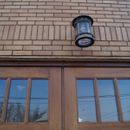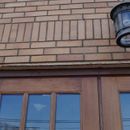Brick cape has iron window headers that bow downward
I own a 1952 brick cape (with no overhangs) in CT that faces the Great Meadows salt marsh off of Long Island Sound. Most weather patterns, coastal breezes, and storms hit my house directly in the face.
When I bought the house, the building inspector found gaps in the brick mortar surrounding the iron headers of all the rough window and door openings. Last year I hired a seasoned brick mason to re-point all the mortar gaps (He did a great job.).
Partway through the project, my mason expressed strong concerns about the iron headers. He showed me how they are bowing downward at their centers (see attached photos), and explained that the mortar gaps were caused by the bowing of the headers. He said he’s never seen anything like this in his career.
He is advising me to let him open up the brick wall above one of the headers to look inside and see what we’re dealing with. I’d rather ignore him and watch the egrets flock in. What should I do?
GBA Detail Library
A collection of one thousand construction details organized by climate and house part












Replies
Dawn,
Your brick angles have failed because they were either inadequately sized or have decayed over time. This leaves the brick over your openings supported by the mortar in between them - for now.
Unfortunately, you need to get a structural engineer to assess the problem and design a solution - which almost invariably will be the replacement of all the angles. Sorry, and good luck.
Dawn,
Malcolm is correct. In the old days, masons would create an arch or a jack arch at window openings, or would install a strong granite lintel to support the masonry above the opening. Done correctly, these methods are excellent. There are plenty of examples of 2,000-year-old Roman arches to show that these methods are very durable. (For more on jack arches, see Quality Issues With Brick Buildings.)
In the U.S., some architects and builders decided (after World War II) that they could get away without these structural features, and could substitute steel angle for a true arch, a jack arch, or a granite lintel.
If the steel angle is properly sized, this approach can work, although (in my opinion) it always looks odd to see a masonry opening with no obvious way for the load above the opening to be supported.
The good news is that problems like this can be fixed. The bad news is that it probably won't be cheap. As Malcom said, the next person to talk to is a structural engineer.
There's a good chance the lintel is properly sized, and what's happening is called "rust jacking." As iron rusts, it expands. Iron oxide takes up more space than iron alone. So the masonry is being pushed upwards, and the lintel itself forced down. You DID say your house faces the Great Meadows salt marsh, although I see this in the midwest far from any saltwater.
A masonry arch, although more expensive to build, has a cheaper life cycle in the end!